Understanding the Causes of Overheating
Overheating or burning of the workpiece surface during rotary tool operations is a common concern in precision metalworking and fabrication. When using carbide rotary burs, this issue typically arises from excessive friction, improper cutting speeds, or inadequate chip removal. Prolonged contact between the bur and the material without effective heat dissipation generates intense localized heat, which may cause discoloration, surface hardening, or permanent damage. The material composition also plays a role; metals like stainless steel and titanium are more heat-sensitive and prone to thermal damage. Identifying the root causes is the one step in applying the correct preventive techniques during operation.

Optimizing Rotational Speed and Feed Pressure
One of the effective ways to reduce overheating is to ensure that the rotational speed and feed pressure are well-matched to the material being processed. Operating the tool at excessively high speeds with too much pressure increases friction and heat generation, especially if the bur becomes bogged down in the material. On the other hand, using a balanced combination of speed and light, consistent pressure enables smooth cutting action and effective chip evacuation. Users should always refer to the manufacturer’s recommended RPM range for specific bur shapes and material types, adjusting as needed to avoid heat buildup on the cutting surface.
Implementing Intermittent Cutting and Rest Periods
Continuous cutting for extended periods without pauses can cause heat accumulation in both the tool and the workpiece. To avoid this, operators can adopt an intermittent cutting technique, allowing short rest intervals between passes. These pauses give both the carbide bur and the material time to cool naturally. This method is particularly beneficial when working on dense or thick metals, where longer contact times result in higher surface temperatures. Intermittent cutting not only preserves the surface integrity of the workpiece but also extends the service life of the rotary bur itself by reducing thermal wear.
Using Effective Cooling and Lubrication Methods
Another key strategy for preventing surface burning is the use of coolants or lubricants during operation. Applying a suitable cutting fluid reduces friction at the contact point and assists in dissipating heat more efficiently. For manual or handheld operations, aerosol-based coolants or mist sprays are commonly used, while CNC setups may employ flood coolant systems for continuous thermal management. In addition to preventing overheating, proper lubrication also enhances chip flow and reduces tool loading. Operators should ensure that the coolant is compatible with both the material and the carbide bur to avoid corrosion or chemical reactions.
Selecting the Right Bur Shape and Flute Design
The design of the carbide rotary bur plays an important role in heat control. Bur shapes with deeper flutes and suitable spacing allow chips to evacuate more quickly, reducing the amount of friction and heat generated during cutting. Choosing a bur specifically designed for the type of material being worked on can significantly impact thermal performance. For example, aluminum-cut burs with wider flute spacing are ideal for non-ferrous metals and help prevent clogging, which otherwise causes overheating. Using the appropriate flute geometry ensures that the tool remains sharp and cool throughout the cutting process.
Maintaining the Sharpness and Cleanliness of the Bur
A dull or clogged carbide rotary bur requires more pressure to cut effectively, which increases friction and heat production. Regular inspection and maintenance of the bur are essential to avoid these issues. Users should clean the bur frequently to remove built-up material and inspect for signs of wear or rounding of cutting edges. Replacing worn burs before they become inefficient helps maintain smooth operation and prevents overheating. Keeping the tool in suitable condition not only protects the workpiece surface but also supports consistent cutting quality.
Conclusion
Preventing surface overheating or burning while using carbide rotary burs involves a combination of proper technique, tool maintenance, and environmental control. By adjusting speed and pressure, implementing cooling strategies, selecting the right tool geometry, and ensuring the bur remains sharp and clean, operators can significantly reduce the risk of thermal damage. These practices not only preserve the appearance and integrity of the workpiece but also enhance overall efficiency and tool longevity in both manual and automated applications.